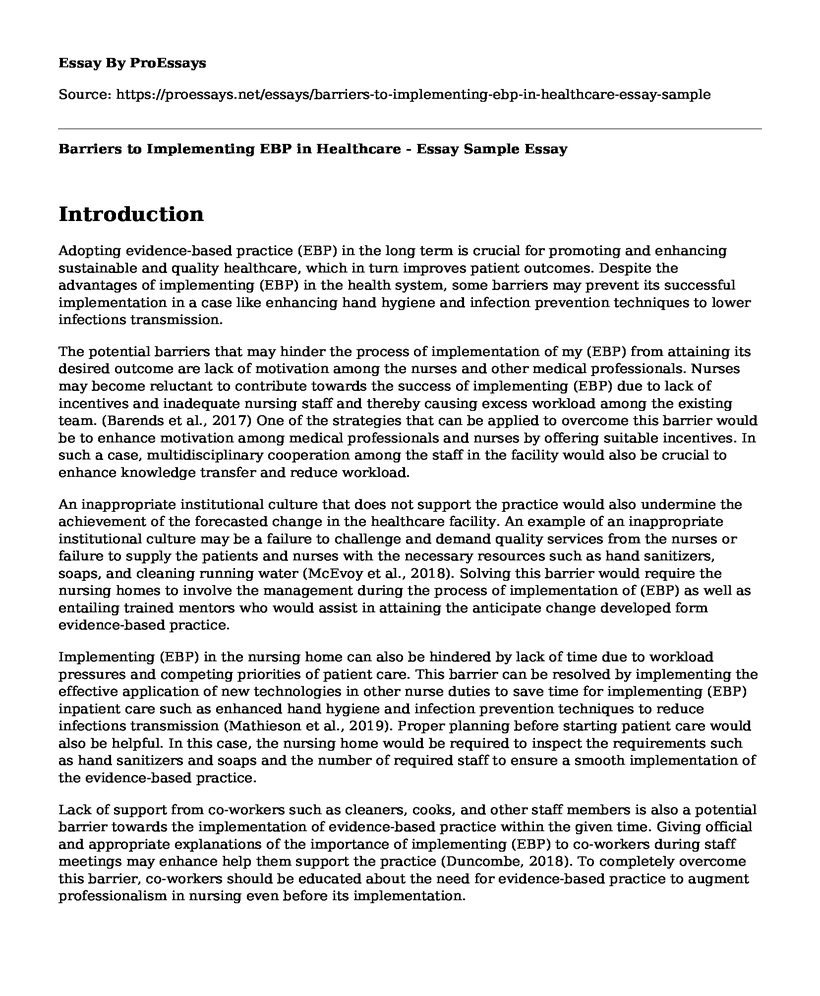Introduction
Adopting evidence-based practice (EBP) in the long term is crucial for promoting and enhancing sustainable and quality healthcare, which in turn improves patient outcomes. Despite the advantages of implementing (EBP) in the health system, some barriers may prevent its successful implementation in a case like enhancing hand hygiene and infection prevention techniques to lower infections transmission.
The potential barriers that may hinder the process of implementation of my (EBP) from attaining its desired outcome are lack of motivation among the nurses and other medical professionals. Nurses may become reluctant to contribute towards the success of implementing (EBP) due to lack of incentives and inadequate nursing staff and thereby causing excess workload among the existing team. (Barends et al., 2017) One of the strategies that can be applied to overcome this barrier would be to enhance motivation among medical professionals and nurses by offering suitable incentives. In such a case, multidisciplinary cooperation among the staff in the facility would also be crucial to enhance knowledge transfer and reduce workload.
An inappropriate institutional culture that does not support the practice would also undermine the achievement of the forecasted change in the healthcare facility. An example of an inappropriate institutional culture may be a failure to challenge and demand quality services from the nurses or failure to supply the patients and nurses with the necessary resources such as hand sanitizers, soaps, and cleaning running water (McEvoy et al., 2018). Solving this barrier would require the nursing homes to involve the management during the process of implementation of (EBP) as well as entailing trained mentors who would assist in attaining the anticipate change developed form evidence-based practice.
Implementing (EBP) in the nursing home can also be hindered by lack of time due to workload pressures and competing priorities of patient care. This barrier can be resolved by implementing the effective application of new technologies in other nurse duties to save time for implementing (EBP) inpatient care such as enhanced hand hygiene and infection prevention techniques to reduce infections transmission (Mathieson et al., 2019). Proper planning before starting patient care would also be helpful. In this case, the nursing home would be required to inspect the requirements such as hand sanitizers and soaps and the number of required staff to ensure a smooth implementation of the evidence-based practice.
Lack of support from co-workers such as cleaners, cooks, and other staff members is also a potential barrier towards the implementation of evidence-based practice within the given time. Giving official and appropriate explanations of the importance of implementing (EBP) to co-workers during staff meetings may enhance help them support the practice (Duncombe, 2018). To completely overcome this barrier, co-workers should be educated about the need for evidence-based practice to augment professionalism in nursing even before its implementation.
Conclusion
The ability to sustain change especially in the implementation of evidence-based practice in a nursing home can be strenuous. For instance, it may be difficult to translate research into practice and also set dynamic changes in institutional culture. Nevertheless, the sustainability of such change is imperative for impacting patient outcomes over time. Therefore, any nursing home of healthcare facility aiming to implement evidence-based practice should be able to address the potential barriers and have strategic plans for overcoming them.
References
Barends, E., Villanueva, J., Rousseau, D. M., Briner, R. B., Jepsen, D. M., Houghton, E., & Ten Have, S. (2017). Managerial attitudes and perceived barriers regarding evidence-based practice: An international survey. PloS one, 12(10).
https://www.ncbi.nlm.nih.gov/pmc/articles/PMC5626028/Duncombe, D. C. (2018). A multiinstitutional study of the perceived barriers and facilitators to implementing evidencebased practice. Journal of clinical nursing, 27(5-6), 1216-1226.
https://onlinelibrary.wiley.com/doi/abs/10.1111/jocn.14168Mathieson, A., Grande, G., & Luker, K. (2019). Strategies, facilitators and barriers to implementation of evidence-based practice in community nursing: a systematic mixed-studies review and qualitative synthesis. Primary health care research & development, 20.
https://www.cambridge.org/core/journals/primary-health-care-research-and-development/article/strategies-facilitators-and-barriers-to-implementation-of-evidencebased-practice-in-community-nursing-a-systematic-mixedstudies-review-and-qualitative-synthesis/74D8FB3E7561129C8CBBF01207837BCC
McEvoy, M. P., Lewis, L. K., & Luker, J. (2018). Changes in physiotherapy students’ knowledge and perceptions of EBP from first year to graduation: a mixed methods study. BMC medical education, 18(1), 109. https://bmcmededuc.biomedcentral.com/articles/10.1186/s12909-018-1212-4
Cite this page
Barriers to Implementing EBP in Healthcare - Essay Sample. (2023, Aug 10). Retrieved from https://proessays.net/essays/barriers-to-implementing-ebp-in-healthcare-essay-sample
If you are the original author of this essay and no longer wish to have it published on the ProEssays website, please click below to request its removal:
- Child's Developmental Needs - Paper Example
- Paper Example on Environmental Health
- Malignant Transformation of Recurrent Nasopharyngeal Angiofibroma in Elderly Male: Case Study
- Essay Example on Drug Injection in Public Washrooms: A Sanitary Problem
- Essay Example on 5 Steps to Meeting Nursing Practice Standards
- Essay on Aging Care in Australia: Need for Increased Spending for Justice
- Paper Example on Fall Prevention in Older Adults: Assessing the Economic Burden







